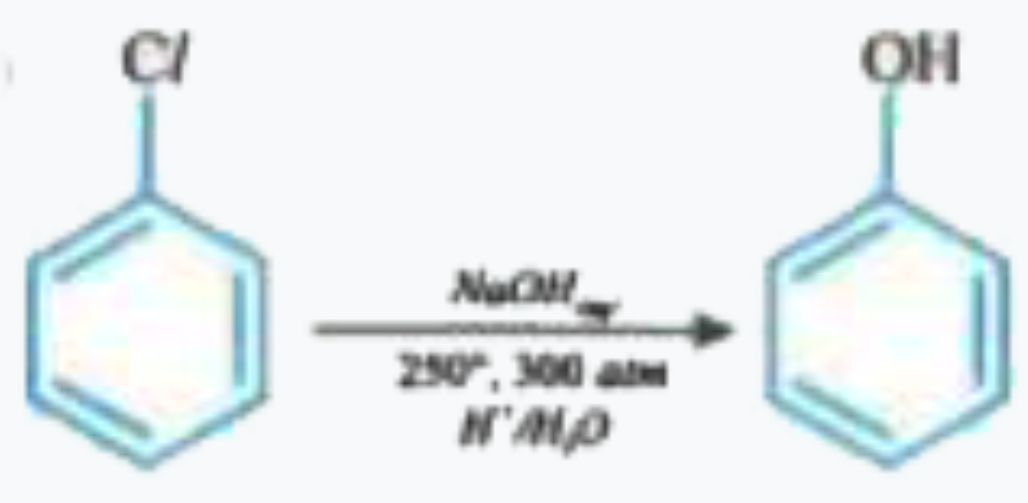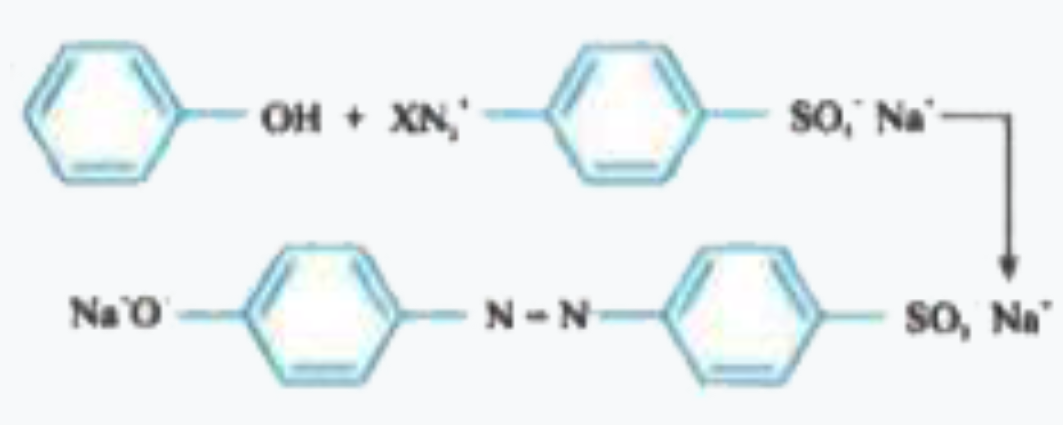The example of an electrophilic substitution reaction is


H2C=CH−CH3HBr−−−−→peroxide
Br2−CH2−CH2−CH3
H2CH2−CH2−O∣∣C−CH3
The correct Answer is:B
To determine the example of an electrophilic substitution reaction from the given options, we can analyze each option step by step.
Step 1: Identify the Reactions
We have four options to consider, and we need to identify which of these represents an electrophilic substitution reaction.
Step 2: Analyze Each Option
1. Chlorobenzene with NaOH:
- This reaction involves the substitution of the chlorine atom in chlorobenzene with a hydroxyl group (OH) to form phenol. This is a nucleophilic substitution reaction, not electrophilic.
2. Phenol with Diazonium Salt (N2+ and SO3-Na+):
- In this case, phenol reacts with a diazonium salt, which acts as an electrophile. The electrophilic substitution occurs where the diazonium ion substitutes for a hydrogen atom on the benzene ring of phenol, leading to the formation of a colored azo compound. This is indeed an electrophilic substitution reaction.
3. HBA in the presence of peroxide:
- This reaction follows a radical mechanism and does not involve electrophilic substitution. It typically leads to anti-Markovnikov addition, which is not what we are looking for.
4. Ketone with Strong Base (LDA):
- The reaction of a ketone with a strong base leads to the formation of an enolate ion, which acts as a nucleophile. This is also a nucleophilic substitution reaction, not electrophilic.
Step 3: Conclusion
From the analysis, the only reaction that qualifies as an electrophilic substitution reaction is the one involving phenol and diazonium salt. Therefore, the correct answer is:
B. Phenol with Diazonium Salt (N2+ and SO3-Na+)
We have four options to consider, and we need to identify which of these represents an electrophilic substitution reaction.
1. Chlorobenzene with NaOH:
- This reaction involves the substitution of the chlorine atom in chlorobenzene with a hydroxyl group (OH) to form phenol. This is a nucleophilic substitution reaction, not electrophilic.
- In this case, phenol reacts with a diazonium salt, which acts as an electrophile. The electrophilic substitution occurs where the diazonium ion substitutes for a hydrogen atom on the benzene ring of phenol, leading to the formation of a colored azo compound. This is indeed an electrophilic substitution reaction.
- This reaction follows a radical mechanism and does not involve electrophilic substitution. It typically leads to anti-Markovnikov addition, which is not what we are looking for.
- The reaction of a ketone with a strong base leads to the formation of an enolate ion, which acts as a nucleophile. This is also a nucleophilic substitution reaction, not electrophilic.
From the analysis, the only reaction that qualifies as an electrophilic substitution reaction is the one involving phenol and diazonium salt. Therefore, the correct answer is:
Topper's Solved these Questions
Similar Questions
Knowledge Check
- Question 1 - Select One

The mechanism of an electrophilic substitution reaction is
Which of the following is not ture.AIncreasing the resonance of II will increases rate of reactionBincreasing the density of electron in I will increase the rate of reaction.CTreatment of base in step-II will increase the rateDTemperature increasing will accelerate the rate of reaction. - Question 2 - Select One
Order of rate of electrophilic substitution reaction is :
 A1>2>3>4B4>3>2>1C2>1>4>3D2>1>3>4
A1>2>3>4B4>3>2>1C2>1>4>3D2>1>3>4 - Question 3 - Select One
In electrophilic substitution reaction nitrobenzene is
AMeta-directingBOrtho-directingCPara-directingDNot reactive and does not undergo any substitution
For an electrophilic aromatic substitution reaction
View SolutionCorrect order of electrophilic substitution reaction is :
 View Solution
View SolutionReimer Tiemann reaction is an electrophillic substitution reaction in which the electrophile is
View SolutionMore reactive haloarenes in electrophilic substitution reaction is
View SolutionThe most reactive compound in electrophilic substitution reaction is
View Solution

